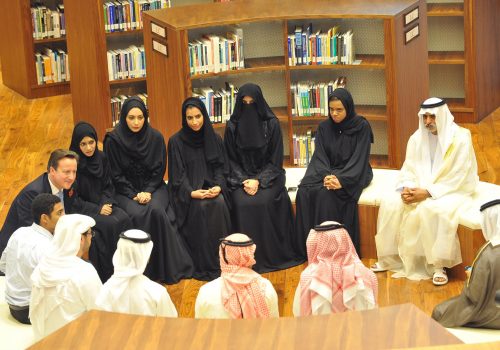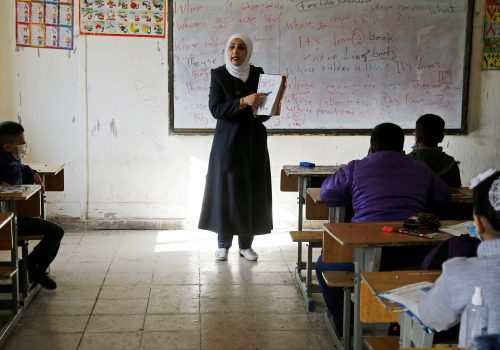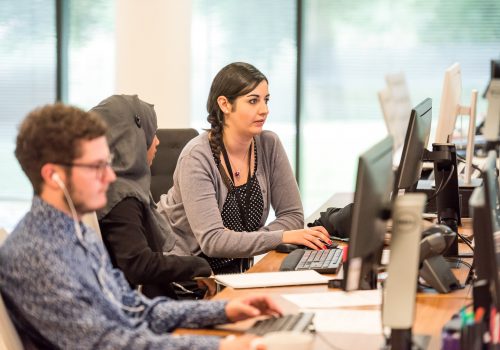I was once denied an education in Iraq. This is why the Taliban’s prohibition on female education matters.
If one could think about how difficult it is when society’s customs and laws conflict with an individual’s fundamental rights, especially the right to an education, then one can begin to understand the plight of Afghan women today.
I certainly do. Growing up in Srechka, a small rural village in northern Iraq, I experienced firsthand the limitations placed on me because of my gender. I longed for an education, but cultural norms and traditions dictated that girls should stay home and take care of the household while boys were expected to work and provide for the family. Education was seen as a threat against those norms, which were upheld by villagers for decades despite what was written in the Iraqi constitution.
Despite these limitations, I never gave up on my quest for knowledge because I understood the significance of education in fulfilling my potential. Unfortunately, in 2014, I was compelled to leave Srechka due to the invasion of my town by the Islamic State of Iraq and al-Sham (ISIS). These events added to my challenges in accessing education. However, my determination to overcome these obstacles only grew stronger as I realized the transformative power of education in shaping individuals as agents of change and empowering them to contribute to the development of their communities.
Years of turmoil and insufficient investment in Iraq have deteriorated the once-excellent education system and limited Iraqi children’s opportunities for quality education. At present, roughly 3.2 million Iraqi children of school age are not receiving an education. Furthermore, under-investment in the educational sector has impaired students’ access to quality learning and the ability to acquire skills necessary to meet the demands of the market. Of the children not enrolled in primary school, 56 percent are female (this number is 65 percent in the case of lower secondary school).
The COVID-19 pandemic has exacerbated this issue, leading to high dropout rates for both genders, although females are disproportionally impacted. Factors that impede Iraqi women from obtaining an education are socially-constructed gender norms, perceived protection concerns, trauma, internal displacement, early and forced marriages, and economic and financial hardships. In rural areas, the data on female dropouts is scarce, and they are among the nation’s most at-risk groups for child marriages.
Unfortunately, the situation in Afghanistan today is not much different from what I experienced in Iraq. The Taliban’s prohibition on female education is a severe blow to the progress made in recent years toward gender equality in the country. Afghan women and girls have been fighting for their right to education, and it is a devastating setback to see their hard-won progress threatened by the Taliban’s oppressive regime.
The Taliban’s actions violate the basic human rights of Afghan women and girls and also have long-term implications for Afghanistan’s economic and social development. Education is essential for individuals to fulfill their potential and contribute to the development of their communities. The denial of education to women and girls hinders their ability to participate in the workforce and limits their potential for upward social mobility.
Taliban prohibits girls’ education, undoing years of progress in Afghanistan
Since the Taliban’s rise to power in 2021, one of their first acts was implementing a strict interpretation of Islamic law. This included the prohibition of girls from attending school and university, as the group believed that education was not necessary nor appropriate for women.
Prior to 2021, in the years after the US invasion of Afghanistan in 2001, the United States and its allies focused on rebuilding and modernizing the country’s infrastructure, including its education system.
As part of its efforts to rebuild Afghanistan since 2002, the US provided approximately $88 billion in security aid, $36 billion in civilian aid (which includes $787 million designated for the advancement of Afghan women and girls), and almost $3.9 billion in humanitarian aid from the United States, according to data shared by the White House.
These different funds supported the construction of new schools, training of teachers, and development of educational materials. The US also worked with Afghan authorities and international organizations to promote access to education, particularly for girls and women who had been largely excluded from the education system under the Taliban. Since 2002, the US has granted Afghanistan $133 billion in economic and security help, including allocating funds for infrastructure, economic and social progress, and security forces.
These efforts have helped to increase enrollment in schools, particularly among girls and women, and to improve the quality of education in Afghanistan. According to the World Bank, the percentage of female enrollment in primary school rose from zero to 85 percent in 2019. However, the situation was still far from ideal, as many families continued to be resistant to the idea of educating their daughters, and there were still areas of the country where the Taliban had a strong presence and where girls’ education was not allowed.
However, it is widely recognized that the assurances made have not been upheld and that the severity of the matter is undeniable.
When the Taliban first seized control, they declared that classrooms would be segregated by gender. Then, they refused to reopen secondary schools for females. In December 2022, with one single decision, the Taliban banned female education by prohibiting females from attending universities, thus, widening the scope of their restriction on female education.
The consequences on economic development
These recent bans have erased years of gender equality progress made in Afghanistan. This has had a devastating effect on the education and rights of Afghan women, who have faced severe restrictions on their freedom and rights for decades. This also hinders the economic development of the country. Education is a key driver of economic growth, and providing education to girls can significantly impact a country’s economy.
As of 2023, there remains a significant dearth of statistics production in Afghanistan, making it difficult to assess the state of the economy fully. However, despite this challenge, experts predict that the country’s economic output could decline by as much as 20 to 30 percent over the course of the year from August 2021.
Furthermore, nearly 97 percent of Afghanistan is facing the risk of poverty, with more than half of the country depending on humanitarian aid to survive. The average Afghan household already spends 91 percent of its income on food, leaving little for other basic needs. This dire situation has resulted in many families resorting to rationing and other strategies to cope with the economic strain—such as selling their kidneys—to put food on the table. Children are particularly vulnerable in this situation, as they are at an increased risk of starvation, malnutrition, hunger, and preventable diseases.
Furthermore, a recent United Nations International Children’s Emergency Fund (UNICEF) analysis argues that the denial of secondary education for girls in Afghanistan has had a significant economic impact, resulting in a loss of at least $500 million within the last year alone. This statistic is a stark reminder of the importance of ensuring girls’ access to education. Not only does education empower girls to make decisions and lead more fulfilling lives, but it also has economic benefits for their communities.
Educating girls has been shown to have a multiplier effect on economic growth and development. When girls are educated, they are more likely to become successful members of society, contributing to the economy and increasing the overall standard of living. Education should be seen as a right and an investment in the future of entire communities.
The economic benefits of educating girls are undeniable in reducing poverty and providing more ways for them to contribute to the economy. Education is a powerful tool for breaking the cycle of poverty, and it can help girls and women access better-paying jobs and become more financially independent. This can increase the standard of living for girls and their families and significantly contribute to the country’s overall economic development.
Denying women access to education and employment in Afghanistan will cost the country up to $1 billion, or a maximum of 5 percent of its GDP—an amount that is too much for the nation to bear due to its present economic circumstances.
Studies have shown that educating women can reduce poverty levels in a country. Educated women are more likely to be employed and have higher incomes, which will help lift them and their families out of poverty. Furthermore, educated women are more likely to have healthier pregnancies, improved health outcomes for their children, and increased access to basic services like health care and sanitation. This will lead to a healthier population and improved quality of life.
Advancing female education under the Taliban
Despite the new government in Afghanistan abandoning its promises of reform, the international community must remain steadfast in its commitment to safeguarding the rights of Afghan women and girls. It is also essential that they continue to pressure the Afghan government to uphold its commitments to reform and protect the rights of its female citizens. Furthermore, the international community should provide support and resources to organizations and initiatives working to empower Afghan women and girls. Only through collective action can the rights of Afghan women be fully secured.
Given the Taliban’s police state and severe threat of repression against advocacy for women’s rights in the country, especially regarding reversing the female education ban, a few key strategies can be implemented to ensure female education. These strategies can minimize repression risks without formally recognizing the legitimacy of the Taliban.
- Collaborate with reputable and recognized local and national organizations to develop a coordinated and strategic approach to promoting female education in Afghanistan. This should involve creating partnerships between the government, NGOs, and other international organizations that are recognized by the international community. This strategy should involve advocacy and awareness-raising to educate the public on the importance of female education and the negative impact of the Taliban’s ban. It should also involve providing financial incentives to families to encourage them to send their daughters to school.
- Provide security measures to protect girls and women from violence and harassment as they travel to and from school. This could involve training security forces to respond to incidents of harassment and ensuring that girls and women feel safe. It could also involve providing transport options to help girls and women travel safely to and from schools.
- Prioritize community-based education programs that are accessible and safe for girls and women. This could involve providing alternative education programs in safe settings, such as at home or in community centers. It could also involve providing resources to local organizations to help them provide quality education to girls and women.
As an Iraqi refugee who understands the importance of education, I recognize that achieving gender parity in education is critical for Afghanistan’s long-term economic growth and prosperity. Education is a fundamental right and a key driver of economic development, and denying girls access to education is detrimental to the country’s future. It is only through collective action that the international community can ensure the rights of Afghan women and girls are upheld and that they can live in a society where education is a privilege, not a punishment.
Nibras Basitkey is a program assistant at the Atlantic Council’s empowerME Initiative at the Atlantic Council’s Rafik Hariri Center for the Middle East.
Further reading
Tue, Sep 29, 2020
Absence of PhD programs contributes to weak research and development in the Gulf
MENASource By
The production of new knowledge is a very complex process and many factors contribute to the low levels of innovation exhibited by the Gulf countries. One factor that plays a role is the structure of tertiary education—particularly PhD programs.
Mon, Jul 26, 2021
An “illiterate generation”—one of Iraq’s untold pandemic stories
MENASource By
The devastating impacts of COVID-19, coupled with years of spillover effects of violent conflict and extremism, have already proved to be detrimental to students whose education and future career ambitions already receive limited attention.
Mon, Mar 8, 2021
Celebrating MENA women entrepreneurs and business leaders
MENASource By
In honor of International Women’s Day, the Atlantic Council’s empowerME asked Middle East business leaders and government officials to share a "shout out" about a woman entrepreneur or business leader who inspires them
Image: Hadia, 10, a 4th grade primary school student, solves a mathematical equation on a whiteboard in a classroom in Kabul, Afghanistan, October 26, 2021. The hardline Islamist Taliban movement, which stormed to power earlier this year after ousting the Western-backed government, has allowed all boys and younger girls back to class, but has not let girls attend secondary school. "I'm in the 4th grade. I want to be a doctor, but if in two years' time I am not be allowed to continue my studies like my sister, I won't be able to fulfil my dream," said Hadia. "That already scares me." REUTERS/Zohra Bensemra


